珠江三角洲平原不同种植年限土壤铁氧化物特征研究*
2017-08-31贾重建瑛熊崔启超刘红宜秦海龙高玉洁
贾重建 卢 瑛熊 凡 崔启超 刘红宜 秦海龙 姜 坤 高玉洁
(华南农业大学资源环境学院,广州 510642)
珠江三角洲平原不同种植年限土壤铁氧化物特征研究*
贾重建 卢 瑛†熊 凡 崔启超 刘红宜 秦海龙 姜 坤 高玉洁
(华南农业大学资源环境学院,广州 510642)
珠江三角洲平原具有上千年的围垦历史,其土壤发生演变过程深受人为作用影响,开展此区域不同种植年限土壤中铁氧化物形态特征和分布规律的研究,能够揭示人为耕种下土壤发生演变过程。以珠江三角洲平原不同种植年限的土壤剖面为对象,研究了滨海沉积物、河流冲积物和三角洲沉积物发育的土壤及黏粒中全铁、游离铁含量变化及其影响因素。结果表明:随着种植年限的增加,河流冲积物、三角洲沉积物发育土壤中游离铁(Fed)向土体下部淀积深度逐渐增加,黏粒中游离铁(Fed(clay))含量在水耕氧化还原层中呈减小趋势,而滨海沉积物发育的土壤Fed含量及淀积深度均有所减小。随着种植年限的增加,滨海沉积物发育的土壤全铁(Fet)和游离铁(Fed)在黏粒中的富集程度呈增大趋势,而河流冲积物、三角洲沉积物发育的土壤Fet和Fed富集程度逐渐减小。土壤Fed与Fet、黏粒游离铁(Fed(clay))与黏粒全铁(Fet(clay))均呈极显著正相关;全铁富集率(Fet(clay)/Fet)、游离铁富集率(Fed(clay)/Fed)均与Fet(clay)、Fed(clay)、黏粒铁游离度(Fed(clay)/ Fet(clay))呈极显著正相关,与Fet、Fed、土壤铁游离度(Fed/Fet)、黏粒含量呈极显著负相关,且Fet(clay)/Fet与Fed(clay)/Fed呈极显著正相关,表明土壤铁氧化物在黏粒中的富集以Fed为主,且铁氧化物的富集程度受土壤黏粒含量的影响。
铁氧化物;淋溶淀积;种植年限;成土母质;珠江三角洲
铁氧化物在土壤中广泛存在,其活性高、地球化学敏感性强,环境条件稍有变化即可对铁氧化物的形态和特性产生影响[1-2],常作为成土过程和成土环境的指示物,被认为是土壤发生和发育的函数[3],可以被用来评价土壤相对成土年龄[4-7]。因此,土壤铁氧化物特性的研究一直是土壤发生学的重要研究领域之一[2,8-14]。
许多时间序列研究阐述了土壤中铁氧化物一般会随土壤年龄的增加呈现规律性的变化[15-16]。杨艳芳等[16]通过研究广东省南部雷州半岛第四纪以来不同时代喷发的玄武岩发育的土壤,发现游离铁、铁游离度与成土年龄有较好的正相关性。Lair等[17]研究发现多瑙河泛滥平原河流冲积物发育的土壤中铁活化度随成土年龄的增加而降低。有研究表明滨海沉积物发育的水稻土(水耕人为土)中游离铁的分异程度随植稻年限的延长而增强[15,18];紫色砂页岩、第四纪红黏土和红砂岩发育的水耕人为土中全铁、游离铁含量随种稻年限的增加呈逐渐降低趋势[19]。
珠江三角洲平原地处华南地区,具有1000多年的围垦种植历史,其土壤发生演变过程深受人为作用的影响[20]。有关珠江三角洲平原土壤磷形态特征研究已见报道[21],但有关不同种植年限土壤及其黏粒中铁氧化物变化特征鲜见报道。本文拟以不同种植年限的滨海沉积物、河流冲积物和三角洲沉积物发育的土壤为对象,分析土壤及黏粒中铁氧化物含量及其影响因素,旨在揭示人为耕种下土壤发生演变规律,为土壤资源的可持续利用与管理提供理论依据。
1 材料与方法
1.1 供试土壤
珠江三角洲平原地区的围垦历史有比较可靠的资料记录,根据《珠江三角洲堤围水利与农业发展史》[22]、《广东省中山市地名志》[23]、《广州市地名志》[24]、《江门市地名志》[25],并结合刘岳峰等[26]、张振江[27]、王彬等[28]、邓芬[29]众多相关研究结果,得到了大概的土壤耕作种植年限;然后选取由滨海沉积物、河流冲积物、三角洲沉积物发育的土壤样点,挖掘剖面。采集各发生层土壤样品,土壤经室内风干后,过2 mm、0.25 mm、0.15 mm尼龙筛密封储存、备用。采样点基本信息见表1。
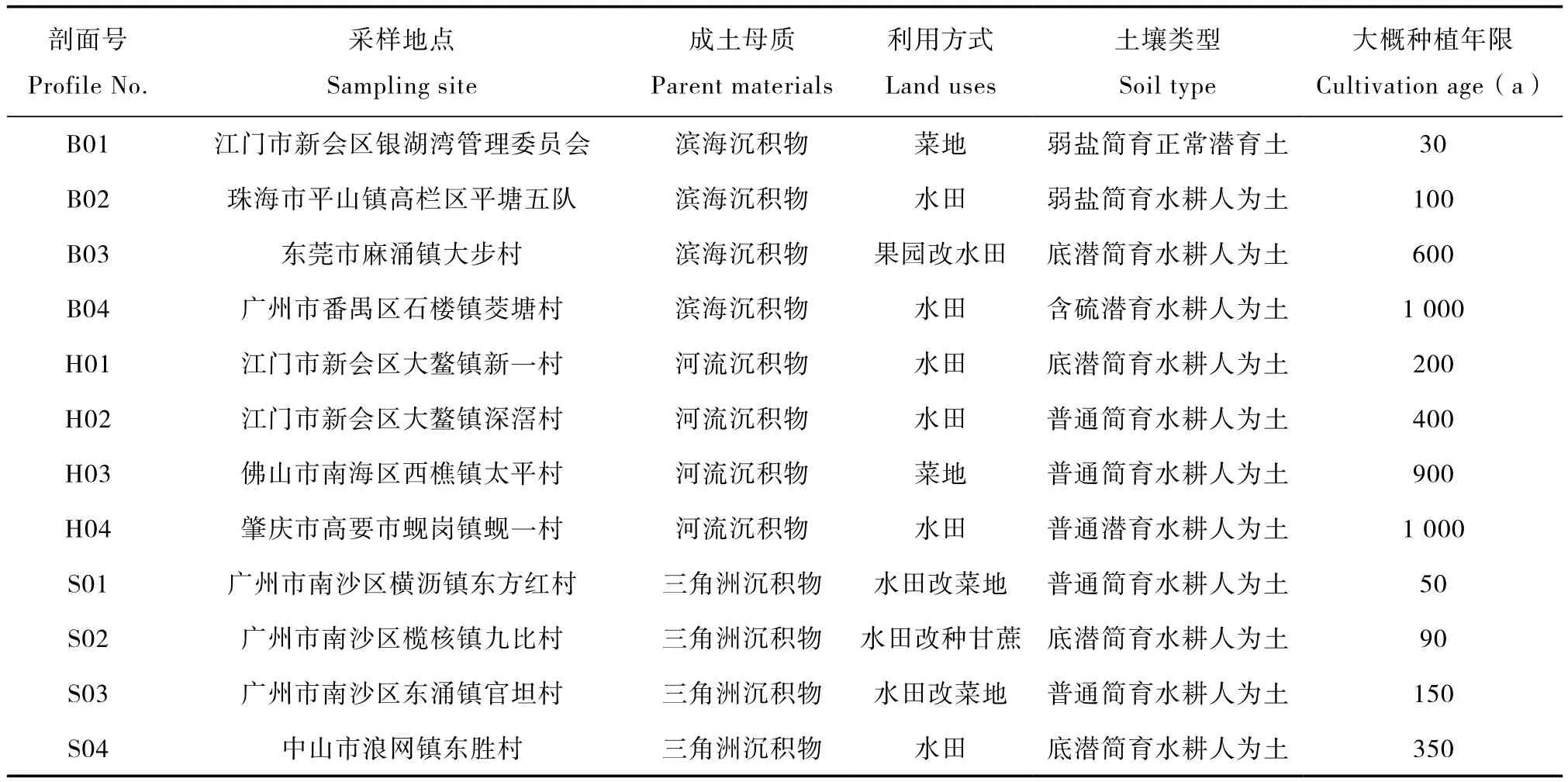
表1 土壤采样点基本信息Table 1 Basic information of the soil sampling sites
1.2 样品分析
土壤黏粒提取:根据斯笃克斯定律采用沉降虹吸分离法;土壤颗粒组成采用吸管法测定;土壤pH采用电位法(水土比2.5∶1)测定;土壤有机碳(SOC)采用重铬酸钾-浓硫酸—外加热法测定;土壤全磷采用碳酸锂-硼酸熔融—钼锑抗比色法测定;土壤全铁(Fet)及黏粒全铁(Fet(clay))采用碳酸锂-硼酸熔融—邻菲罗啉比色法测定;游离铁(Fed)及黏粒游离铁(Fed(clay))采用连二亚硫酸钠-柠檬酸钠-碳酸氢钠浸提—邻菲罗啉比色法测定[30]。供试土壤基本理化性质见表2。
1.3 数据处理与分析
采用Microsoft Excel 和SPSS 20.0 软件进行相关的图表处理及统计分析。
2 结 果
2.1 不同种植年限土壤中铁氧化物特征
从不同种植年限土壤剖面的Fed含量(图1)可以看出,滨海沉积物土壤30 a和100 a剖面中的Fed含量远高于600 a和1 000 a剖面中的Fed含量;河流冲积物土壤随着种植年限的增加,在30 cm,即亚表层以下Fed含量呈减少趋势;三角洲沉积物发育的土壤随着种植年限的增加(50 a除外),剖面中Fed含量呈升高趋势,以上结果表明,随着种植年限的增加,滨海沉积物、河流冲积物发育土壤中铁氧化物有迁移出土体的趋势,而三角洲沉积物发育土壤中氧化铁有富集的趋势。
从图2中可以看出,3种成土母质土壤铁游离度(Fed/Fet)在剖面内的分布与Fed的变化趋势基本一致。滨海沉积物发育的土壤剖面30 a和100 a的Fed/Fet高于种植年限达600 a和1 000 a时的Fed/Fet,且在30 cm深度以下,即在水耕氧化还原层随着种植年限的增加呈减小趋势;河流冲积物、三角洲沉积物发育土壤Fed/Fet随着种植年限的增加,其在剖面内的分布无明显变化规律。
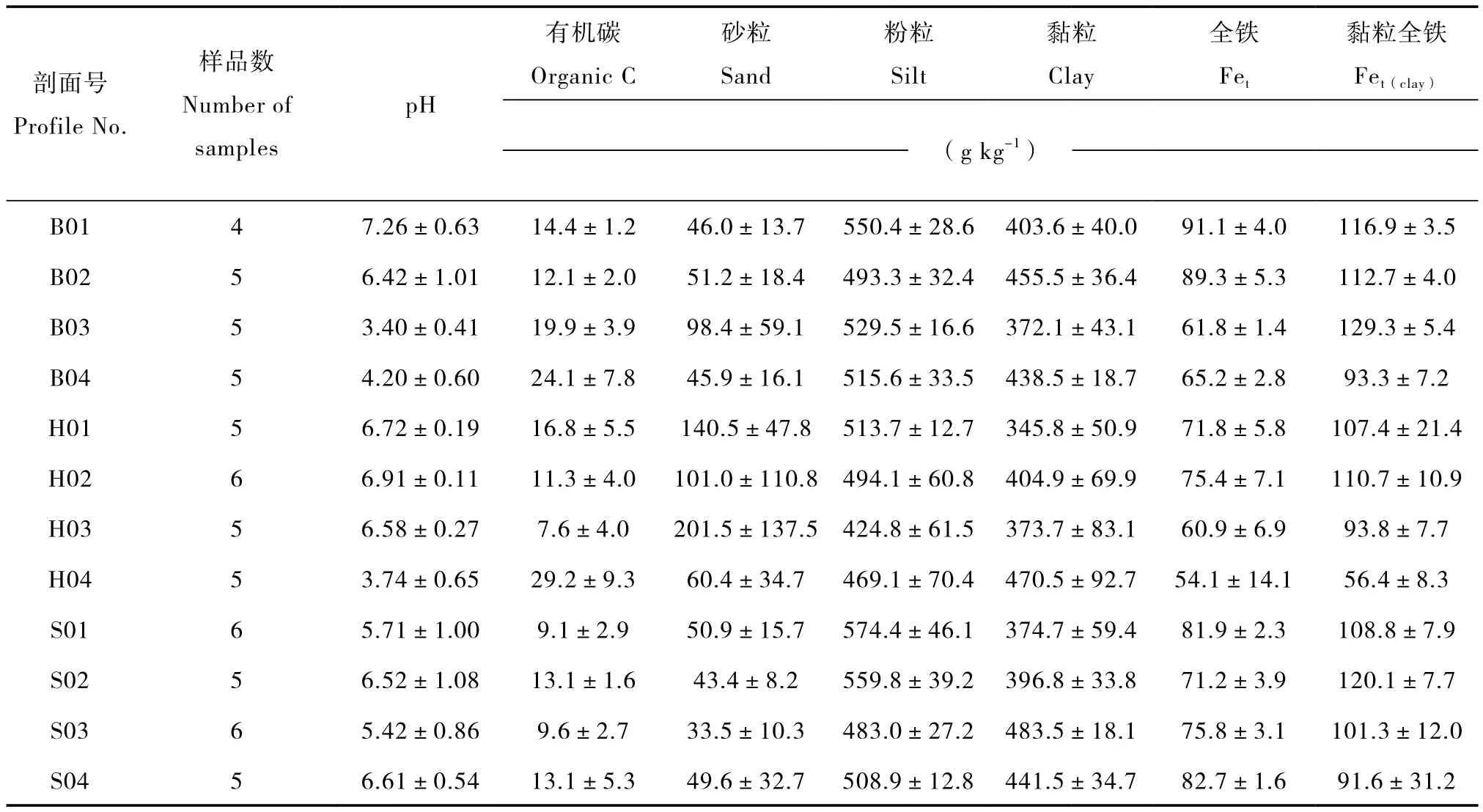
表2 供试土壤基本理化性质Table 2 Basic properties of the studied soils
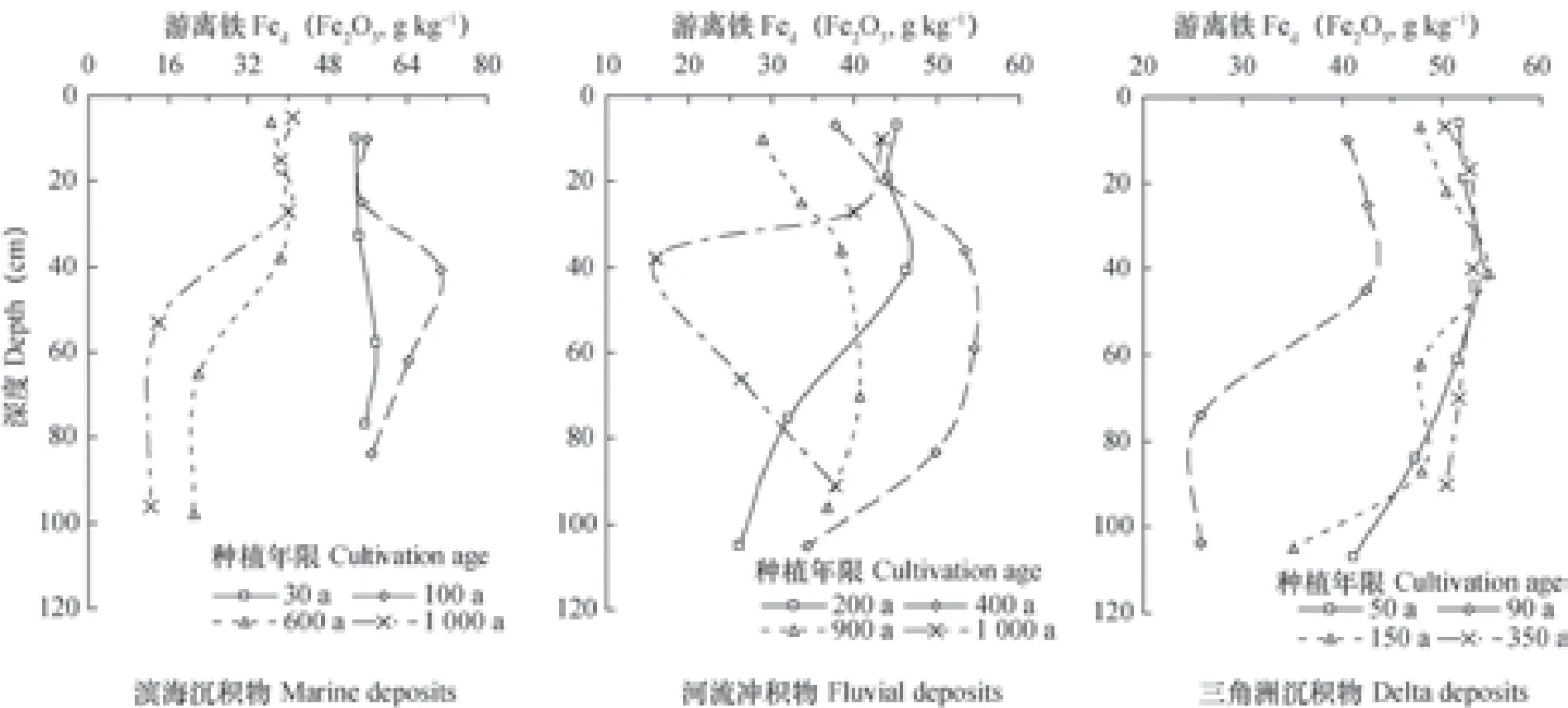
图1 不同种植年限土壤剖面中游离铁含量Fig. 1 Distribution of Fedin soil profiles different in cultivation age

图2 不同种植年限土壤剖面中的铁游离度Fig. 2 Distribution of Fed/Fetin soil profiles different in cultivation age

图3 不同种植年限土壤剖面游离铁的淀积系数Fig. 3 The illuvial coefficient of Fedin soil profiles different in cultivation age
陈留美和张甘霖[15]通过氧化还原层中最大Fed的淀积量与表层Fed的比值来指示剖面中Fed的分异程度。本研究中,将土壤剖面耕作表层以下发生层Fed含量与耕作表层Fed含量的比值称之为淀积系数,淀积系数>1则表明Fed在该发生层中有淀积现象,淀积系数的大小即分异程度的强弱。不同种植年限土壤Fed的淀积系数见图3,滨海沉积物发育的土壤,种植年限为30 a时剖面中Fed淀积系数均在1以上,种植年限为100 a和600 a时,部分发生层淀积系数>1,种植年限为1 000 a时,剖面各层次淀积系数均小于1,表明随着种植年限的增加,Fed淀积程度减弱,淀积深度减小;河流冲积物土壤剖面中,Fed存在淀积现象的发生层深度随种植年限的增加呈增大趋势(1 000 a除外);三角洲沉积物发育的土壤剖面,当种植年限为50 a、90 a、150 a和350 a时,Fed深度分别为40 cm、45 cm、80 cm和90 cm,表明随着种植年限的增加,三角洲沉积物发育的土壤剖面游离铁淀积深度逐渐增加。
2.2 不同种植年限土壤黏粒中铁氧化物特征
3种成土母质发育的土壤Fed(clay)含量在剖面中的分布随种植年限的变化见图4,滨海沉积物发育的土壤中Fed(clay)在剖面中的分布,随着种植年限的增加无明显的变化规律;河流冲积物、三角洲沉积物发育的土壤中Fed(clay)含量分别在40 cm和60cm深度以下随着种植年限的增加而减少。
由图5可知,滨海沉积物发育的土壤中黏粒铁游离度(Fed(clay)/Fet(clay))随着种植年限的增加无明显的变化规律;而河流冲积物、三角洲沉积物发育的土壤Fed(clay)/Fet(clay)分别在40 cm深度和60cm深度以下随着种植年限的增加而减小。这与Fed(clay)在剖面内的变化趋势基本一致(图4)。

图4 不同种植年限土壤剖面中黏粒游离铁含量Fig. 4 Distribution of Fed(clay)in soil profiles different in cultivation age
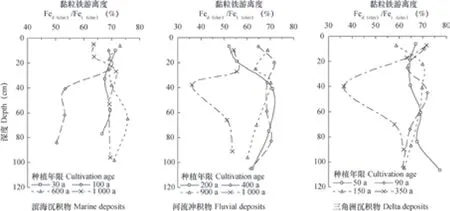
图5 不同种植年限土壤剖面中的黏粒铁游离度Fig. 5 Distribution of Fed(clay)/Fet(clay)in soil profiles different in cultivation age
2.3 土壤铁氧化物在黏粒中的富集程度
在土壤形成过程中,铁氧化物会向较细的粒级富集。用黏粒和土壤中铁氧化物含量的比值可表示铁富集率,指示铁的富集程度[2]。Fet和Fed向黏粒的富集程度见图6,大部分黏粒Fet(clay)、Fed(clay)含量分别高于相应的土壤中Fet、Fed的含量,这表明土壤中铁氧化物有向黏粒富集的趋势。滨海沉积物发育的土壤30 a和100 a的剖面中Fet、Fed的富集程度弱于600 a和1 000 a的土壤;河流冲积物发育土壤在深度40 cm以下土层中Fet、Fed的富集程度随着种植年限的增长呈增加趋势;三角洲沉积物发育的土壤种植年限为350 a 剖面中Fet、Fed的富集程度弱于种植年限较短的土壤。这表明随着种植年限的增长,滨海沉积物发育的土壤铁氧化物在黏粒中的富集程度增大,而河流冲积物、三角洲沉积物发育的土壤铁氧化物在黏粒中的富集程度呈减小趋势。Fet和Fed的富集程度在剖面内呈相似的变化特征,但Fed的富集程度强于土壤Fet,这表明铁氧化物的富集以Fed为主。
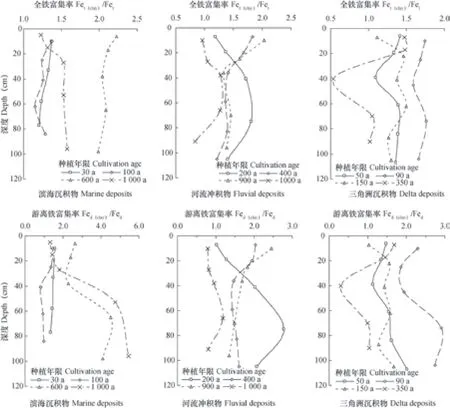
图6 不同种植年限土壤剖面全铁和游离铁在黏粒中的富集程度Fig. 6 Fetand Fedenrichment ratios in clay in soil profiles different in cultivation age
2.4 土壤铁氧化物的相关性
Pearson相关性分析结果显示(表3),Fed与Fet、Fed(clay)与Fet(clay)均呈极显著正相关,Fet(clay)、Fed(clay)与黏粒均呈极显著负相关;Fet(clay)/Fet、Fed(clay)/Fed均与Fet(clay)、Fed(clay)、黏粒铁游离度呈极显著正相关,与Fet、Fed、铁游离度、黏粒含量呈极显著负相关,且Fet(clay)/Fet与Fed(clay)/Fed呈极显著正相关。表明,土壤铁氧化物在黏粒中的富集主要由游离铁的富集引起的,且铁氧化物的富集程度受土壤中黏粒含量的影响。
3 讨 论
珠江三角洲平原包括滨海、三角洲和河流冲积平原区,滨海沉积物发育的土壤,呈带状分布于浅海湾岛屿周围、台山、深圳的滨海平原,土壤是由水下平原经所谓鱼游—橹逼—鹤立—草步等阶段,渐渐露出水面之后进而发育为草坦和林坦而逐步发育形成的;河流冲积物发育的土壤广泛分布于珠江三角洲顶部的东江、北江、西江等下游冲积平原,由河流悬运的泥沙沉积形成;而三角洲沉积物发育土壤受河、海相共同作用[20]。三种成土母质具有明显的差异,所发育的土壤剖面内铁氧化物随耕作种植年限的增加呈现出有差异的变化特征。随着种植年限的增加,滨海沉积物、河流冲积物发育的土壤中游离铁氧化物含量均有所减少,这可能是由于随着耕作种植年限的延长和珠江三角洲的发展,通过自然淹水向土壤输入的物质在减少,进入土壤中的铁氧化物不足以弥补其损失[7]。 三角洲沉积物发育的土壤中游离铁含量则有升高的趋势,说明其输入多于输出。土壤游离铁与铁游离度、黏粒游离铁与黏粒铁游离度在剖面中的分布特征均呈相似的变化趋势,这是由于游离铁在剖面中的迁移转化主要受外部人为水耕成土因素的影响,而水耕人为土发育过程中硅酸盐铁是相对稳定的,这也可以说明游离铁能够影响全铁含量的分布特征,与韩光中等[19]的研究相一致。游离铁与全铁、黏粒游离铁与黏粒全铁均呈极显著正相关(表3),也证明了这一点。

表3 土壤铁氧化物与土壤基本理化性质的相关性Table 3 Pearson correlation coefficients between iron oxides and basic physicochemical properties of the soils(n=62)
在水耕人为土形成和发展过程中,由于铁氧化物的活性较强,易受土壤水分状况的影响,长期处于渍水或季节性渍水环境,铁氧化物发生周期性还原淋溶和氧化淀积作用,从而在不同土层中发生了垂直方向迁移或在同一土层内部发生了局部移动,使铁氧化物在某一土层或某些部位出现不同程度的淋溶和淀积[2,31]。本研究中,随着种植年限的增加,河流冲积物、三角洲沉积物土壤中游离铁淀积深度随着种植年限的增加而增加,但是滨海沉积物发育的土壤游离铁在剖面内的淀积深度反而减小。陈留美和张甘霖[15]研究发现滨海沉积物发育的水稻土随着植稻年龄的增加,游离铁在剖面内的最大淀积量和淀积深度逐渐增加,这与本文中滨海沉积物发育的土壤研究结果不一致,而河流冲积物、三角洲沉积物发育的土壤游离铁随种植年限的变化与Zhang和Gong[7]的研究结果相近,但规律性较弱。这可能是由于珠江三角洲地区人稠地少,人为活动极其频繁,尤其20世纪80年代以来,土壤复种指数越来越高,人为作用对土壤的影响更加强烈,利用方式的改变(如水田改菜地、种甘蔗等)影响土壤的水分、养分管理和土壤物质循环和迁移[31],使得一些时间序列上的发生特性变化规律被弱化。3种成土母质发育的土壤铁氧化物随种植年限的变化呈现有差异性的规律,可能是地表灌水和季节性地下水的影响不一,导致土壤铁氧化物淋溶淀积变化趋势不同。
一般认为在成土过程中铁氧化物会向较细的粒级富集[2],这可能是在湿润或淹水的条件下,由于还原状态的出现,使与黏粒结合的铁氧化物还原成可溶态,并引起黏粒的分散,形成黏粒悬液,从而随渗漏水迁移,却没有经历干燥时的重新凝聚[32],最终可能迁出土体。铁氧化物向黏粒富集的程度能够说明铁氧化物在土壤剖面中活动的强度。本研究中,铁氧化物在土壤黏粒中大多数是富集的,但是富集程度稍有差异。黏粒全铁、黏粒游离铁与黏粒均呈极显著负相关(表3),说明在成土过程中黏粒铁氧化物不仅来自于非黏粒部分的铁化合物,也受淋溶淀积的影响[2]。而河流冲积物、三角洲沉积物发育的土壤中铁氧化物在黏粒中的富集程度随着种植年限的增加而减小,可能是由于铁氧化物在成土过程中淋失或者是脱水老化形成粗颗粒而导致的。
4 结 论
随着种植年限的增加,珠江三角洲平原河流冲积物、三角洲沉积物发育的土壤中Fed有向土体下部淋溶淀积的趋势,且Fed淀积深度呈增加趋势;Fed(clay)含量则在水耕氧化还原层呈减小趋势;滨海沉积物发育的土壤中游离铁含量及淀积深度均有所减小,而Fed(clay)无明显的变化规律。随着种植年限的增长,滨海沉积物发育的土壤铁氧化物在黏粒中的富集程度呈增大趋势,而河流冲积物、三角洲沉积物发育的土壤铁氧化物在黏粒中的富集程度呈减小趋势。土壤铁氧化物在黏粒中的富集以游离铁的富集为主,且铁氧化物的富集程度受土壤中黏粒含量的影响。
[1] 雷梅,常庆瑞,冯立孝,等. 太白山土壤特性及氧化铁发生学特征. 地理研究,2001,20(1):83—90
Lei M,Chang Q R,Feng L X,et al. Soil characteristic and genetic feature of iron oxide of Taibai Mountains(In Chinese). Geographical Research,2001,20(1):83—90
[2] 熊毅. 土壤胶体(第一册). 北京:科学出版社,1983
Xiong Y. Soil colloid(Volume one)(In Chinese). Beijing:Science Press,1983
[3] 黄成敏,龚子同,杨德涌. 海南岛北部玄武岩上土壤发生研究Ⅱ. 铁氧化物特征. 土壤学报,2002,39(4):449—458
Huang C M,Gong Z T,Yang D Y. Genesis of soils derived from basalt in northern Hainan Island Ⅱ. Iron oxides(In Chinese). Acta Pedologica Sinica,2002,39(4):449—458
[4] Shaw J N,Odom J W,Hajek B F. Soils on quaternary terraces of the Tallapoosa River,central Alabama. Soil Science,2003,168(10):707—717
[5] Alexander E B,Holowaychuk N. Soils on terraces along the Cauca River,Colombia:I. Chronosequence characteristics. Soil Science Society of America Journal,1983,47(4):715—721
[6] Mcfadden L D,Hendricks D M. Changes in the content and composition of pedogenic iron oxyhydroxides in a chronosequence of soils in southern California. Quaternary Research,1985,23(2):189—204
[7] Zhang G,Gong Z. Pedogenic evolution of paddy soils in different soil landscapes. Geoderma,2003,115(1):15—29
[8] 李孝良,陈效民,周炼川,等. 喀斯特石漠化地区土壤Fe组成及其发生学意义. 地质通报,2010,29(5):745—751
Li X L,Chen X M,Zhou L C,et al. Characteristics of soil iron and its pedogenetic significance in the process of Karst rocky desertification,southwestern China(In Chinese). Geological Bulletin of China,2010,29(5):745—751
[9] 张治伟,朱章雄,傅瓦利,等. 岩溶山地土壤氧化铁形态及其与成土环境的关系. 环境科学,2012,33(6):2013—2020
Zhang Z W,Zhu Z X,Fu W L,et al. Morphology of soil iron oxides and its correlation with soil-forming process and forming conditions in a Karst Mountain(In Chinese). Environmental Science,2012,33(6):2013—2020
[10] 常庆瑞,冯立孝. 陕西汉中土壤氧化铁及其发生学意义研究. 土壤通报,1999,30(1):14—16
Chang Q R,Feng L X. Studies on soil iron oxide formation and genesis in Hanzhong of Shaanxi Province(In Chinese). Chinese Journal of Soil Science,1999,30(1):14—16
[11] 马毅杰,陈家坊. 我国红壤中氧化铁形态及其特性和功能. 土壤,1998,30(1):1—6
Ma Y J,Chen J F. Morphology,characteristics and function of iron oxide in red soil of China(In Chinese). Soils,1998,30(1):1—6
[12] 傅桦,丁瑞兴. 我国北亚热带白浆化土壤氧化铁的研究. 科技通报,1995,11(6):370—374
Fu H,Ding R X. Studies on iron of albic soils in the northern subtropical region of China(In Chinese).
Bulletin of Science and Technology,1995,11(6):370—374
[13] 赵红挺. 成都平原水稻土中铁的分异特点. 土壤学报,1992,29(2):190—198
Zhao H T. The different characteristics of iron in paddy soil in Chengdu Plain(In Chinese). Acta Pedologica Sinica,1992,29(2):190—198
[14] Rezapour S,Azhah H,Momtaz H R,et al. Changes in forms and distribution pattern of soil iron oxides due to long-term cropping in the Northwest of Iran. Environmental Earth Sciences,2015,73(11):7275—7286
[15] 陈留美,张甘霖. 滨海沉积物发育的水稻土时间序列母质均一性判定与特性演变. 土壤学报,2009,46(5):753—763
Chen L M,Zhang G L. Parent material uniformity and evolution of soil characteristcs of a paddy soil chronosequence derived from marine sediments(In Chinese). Acta Pedologica Sinica,2009,46(5):753—763
[16] 杨艳芳,李德成,张甘霖,等. 雷州半岛玄武岩发育的时间序列土壤的发生演变. 土壤学报,2010,47(5):817—825
Yang Y F,Li D C,Zhang G L,et al. Evolution of chronosequential soils derived from volcanic basalt on tropical Lezhou Peninsula South China(In Chinese). Acta Pedologica Sinica,2010,47(5):817—825
[17] Lair G J,Zehetner F,Hrachowitz M,et al. Dating of soil layers in a young floodplain using iron oxide crystallinity. Quaternary Geochronology,2009,4(3):260—266
[18] 程月琴,杨林章,孔荔玺,等. 植稻年限对土壤铁锰氧化物的影响. 土壤,2008,40(5):784—791
Cheng Y Q,Yang L Z,Kong L X,et al. Influences of rice-planting duration on iron and manganese oxides in paddy soils(In Chinese). Soils,2008,40(5):784—791
[19] 韩光中,张甘霖. 母质对南方丘陵区水耕人为土理化性质演变的影响. 土壤学报,2014,51(4):772—780
Han G Z,Zhang G L. Influence of parent material on evolution of physico-chemical properties of Hydragric Anthrosols in hilly regions of South China(In Chinese). Acta Pedologica Sinica,2014,51(4):772—780
[20] 陆发熹. 珠江三角洲土壤. 北京:中国环境科学出版社,1988
Lu F X. Soils of the Pearl River Delta(In Chinese). Beijing:China Environmental Science Press,1988
[21] 陈冲,贾重建,卢瑛,等. 珠江三角洲平原土壤磷剖面分布及形态特征研究. 土壤通报,2015,46(5):1025—1033
Chen C,Jia C J,Lu Y,et al. Studies on P distribution and fractions in soil profile of cultivated land in Pearl River Delta Plain(In Chinese). Chinese Journal of Soil Science,2015,46(5):1025—1033
[22] 赵绍祺,杨智维. 珠江三角洲堤围水利与农业发展史.广州:广东人民出版社,2011
Zhao S Q,Yang Z W. The water resources and agricultural development history in the Pearl River Delta(In Chinese). Guangzhou:Guangdong People’s Publishing House,2011
[23] 广东省中山市地名志编纂委员会. 广东省中山市地名志. 广州:广东科学技术出版社,1989
The Compilation Committee of Toponymy of Zhongshan City Guangdong Province. The toponymy of Zhongshan City,Guangdong Province(In Chinese). Guangzhou:Guangdong Science and Technology Press,1989
[24] 广州市地名委员会. 广州市地名志. 广州:广东科学技术出版社,1989
The Compilation Committee of Toponymy of Guangzhou City. The toponymy of Guangzhou City(In Chinese). Guangzhou:Guangdong Science and Technology Press,1989
[25] 林永年. 江门市地名志. 广州:广东省地图出版社,1991
Lin Y N. The toponymy of Jiangmen City(In Chinese). Guangzhou:Guangdong Cartographic Press,1991
[26] 刘岳峰,韩慕康,邬伦,等. 珠江三角洲口门区近期演变与围垦远景分析. 地理学报,1998,53(6):492—500
Liu Y F,Han M K,Wu L,et al. Recent evolution of outlets in Zhujiang River Delta and the prospect for land reclamatin(In Chinese). Acta Geographica Sinica,1998,53(6):492—500
[27] 张振江. 麻涌村落地名研究——麻涌地名研究之一.西藏民族学院学报(哲学社会科学版),2009,30(2):68—73
Zhang Z J. The study of geographic names about Machong village——One of the study about Machong geographic names(In Chinese). Journal of Tibet Nationalities Institute(Philosophy and Social Sciences Edition),2009,30(2):68—73
[28] 王彬,司徒尚纪,朱竑. 广州市南沙区地名文化研究.华南理工大学学报(社会科学版),2006,8(4):20—24
Wang B,Situ S J,Zhu H. The study on the place name culture of Nansha District in Guangzhou(In Chinese). Journal of South China University of Technology(SocialSciences Edition),2006,8(4):20—24
[29] 邓芬. 桑园围——珠江三角洲最大的堤围工程. 农业考古,2006,25(1):150—155
Deng F. Sang Yuan Dike——The largest dike project in Pearl River Delta(In Chinese). Agricultural Archaeology,2006,25(1):150—155
[30] 张甘霖,龚子同. 土壤调查实验室分析方法. 北京:科学出版社,2012
Zhang G L,Gong Z T. Soil survey laboratory methods(In Chinese). Beijing:Science Press,2012
[31] 章明奎,杨东伟. 南方丘陵地水改旱后土壤发生学性质与类型的变化. 土壤通报,2013,44(4):786—792
Zhang M K,Yang D W. Changes in genetic characteristics and types of soils in hilly regions after alteration from paddy fields to upland(In Chinese). Chinese Journal of Soil Science,2013,44(4):786—792
[32] 于天仁,陈志诚. 土壤发生中的化学过程. 北京:科学出版社,1990
Yu T R,Chen Z C. Chemical processes of soil genesis(In Chinese). Beijing:Science Press,1990
Characteristics of Iron Oxide in Soils Different in Cultivation Age in the Pearl River Delta Plain
JIA Chongjian LU Ying†XIONG Fan CUI Qichao LIU Hongyi QIN Hailong JIANG Kun GAO Yujie
(College of Natural Resources and Environment,South China Agricultural University,Guangzhou 510642,China)
【Objective】The Pearl River Delta Plain,located in South China,has a more-thanone-thousand-year cultivation history,so that the soil therein has been subjected to impacts of intensive anthropogenic activities in its evolution. The knowledge of how the soil evolves under anthropogenic activities is sure helpful to sustainable utilization and management of the soil resources. Being highly active and geochemically sensitive,iron oxides in soil tend to be affected by any slight change in environmental condition in formation and property,so they are often used as an indicator of soil pedogenic process,and considered as a function of soil genesis and development. Therefore,characterization of soil iron oxides has been one of the major fields of the study on soil genesis. In this study an investigation was performed of characteristics of iron oxides in bulk soil and soil clay relative to cultivation age and affecting factors in the Pearl River Delta Plain,in an attempt to reveal how the soil forms and evolves under anthropogenic cultivation in the region. 【Method】Samples were collected from genetic horizons of the soils derived from marine deposits with cultivation age being 30 a,100 a,600 a and 1 000 a,separately,of the soils derived from fluvial deposits with cultivation age being 200 a,400 a,900 a and 1 000 a separately and of the soils derived from delta deposits with cultivation age being 50 a,90 a,150 a and 350 a,separately,in the Pearl River Delta Plain for analysis of physicochemical properties,and total iron(Fet),free iron(DCB-extractable iron,Fed),ratio of Fedto Fet(Fed/ Fet)in bulk soil and clay(Fed(clay)/Fet(clay)),Fedsedimentation coefficient(ratio of Fedin the genetic horizon beneath the surface horizon to Fedin surface horizon)and enrichment rates of Fetand Fedin clay(Fet(clay)/Fetand Fed(clay)/Fed).【Result】 Results show that:(1)Among the soils derived from marine deposits,those,30 a in cultivation age,were all >1 in Fedsedimentation coefficient,regardless of horizon;those,100 a and 600 a in cultivation age,were >1 only in some genetic horizons,and those,1 000 a in cultivation age,were all <1. In the soils derived from fluvial deposits,the generic horizon where Fedsedimentation occurred went deeper with the cultivation age. Among the soils derived from delta deposits,those,50 a,90 a,150 a and 350 a in cultivation age,were found to have genetic horizons as deep as 40-cm,45-cm,80-cm and 90-cm,respectively.(2)In the soils derived from marine deposits,the distribution of Fedin clay(Fed(clay))in soil profile varied irregularly with cultivation age,while in the soils derived from fluvial and delta deposits the content of Fed(clay)in soil layers below 40-cm and 60-cmdepth,respectively,declined with cultivation age.(3)The contents of Fetand Fedin clay were higher than their corresponding ones in bulk soil,Among the soils derived from marine deposits,those,30 a and 100 a in cultivation age were lower than those,600 a and 1000 a in cultivation age,in Fetand Fedenrichment rate. In the soils derived from fluvial deposits Fetand Fedenrichment rates increased with cultivation age in the soil layers below 40-cm. And among the soils derived from delta deposits,those,350 a in cultivation age,were lower than those younger in cultivation age in Fetand Fedenrichment rate. And(4)Fedand Fetin bulk soil was extra-significantly and positively related to Fedand Fetin clay,and so was Fet(clay)/Fetand Fed(clay)/Fedto Fet(clay)Fed(clay)and Fed(clay)/Fet(clay),and Fet(clay)/Fetto to Fed(clay)/Fed,however Fet(clay)/Fetand Fed(clay)/Fedwas extra-significantly and negatively related to Fet,Fed,Fed/ Fetand clay content.【Conclusion】With agricultural cultivation going on,Fedin the soils derived from fluvial and delta deposits tends to leach down and deposit in the lower and lower soil layers;Fedcontent tends to decline in the hydroponic redox layer of the soils derived from marine deposits;iron oxides tend to increase in enrichment rate in clay of the soils derived from marine deposits,but decline in clay of the soils derived from fluvial and delta deposits. However,the iron oxides accumulating in clay of the soils were dominated with Fed,and clay content in the soils is the major factor affecting iron oxide enrichment rate.
Iron oxides;Eluviation-illuviation;Cultivation age;Soil-forming parent material;Pearl River Delta
S151+.1
A
10.11766/trxb201611160502
* 国家自然科学基金项目(41271233)、广东省公益研究与能力建设项目(2014B020206002)和国家科技基础性工作专项重点项目(2008FY110600,2014FY110200)资助 Supported by the National Natural Sciences Foundation of China(No. 41271233),the Public Welfare Research and Capacity Building Project of Guangdong Province(No. 2014B020206002),and the Special Project of National Science and Technology Basic Research(Nos. 2008FY110600,2014FY110200)
† 通讯作者 Corresponding author,E-mail:luying@scau.edu.cn
贾重建(1987—),男,博士研究生,主要从事土壤地球化学、土壤发生演变研究。E-mail:cjjia@stu.scau.edu.cn
2016-11-16;
2017-01-14;优先数字出版日期(www.cnki.net):2017-02-20
(责任编辑:檀满枝)
